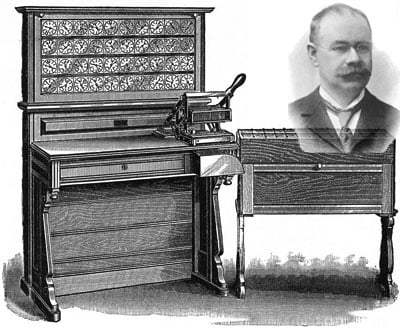
Key Points about Tabulating Machines
Some significant facts about Tabulating machines are as follows.
- The tabulating machine was a counting machine used for the first for tabulating U.S. census data in 1890.
- Herman Hollerith invented the tabulating machine. It kept track of the number of cards that had a hole punched at a specific location.
- It cannot be considered a computer as it could only tabulate (count) and couldn’t be programmed, although it represents an early part of computer history.
- There were no printing options available at the time of its invention. A tabulation’s findings had been read on the counter dials and written down by hand.
- It contained 40 counters, allowing it to count the number of cards with holes punched in up to 40 spots simultaneously. A skilled operator could tabulate between 50 and 80 cards per minute.
Tabulating Machine: History
The Tabulating Machine was made for the betterment of the counting procedure during the U.S. census of 1890. For corporate applications like accounting and inventory control, later models were frequently employed. It gave rise to a new machine category called unit record equipment and the data processing business.
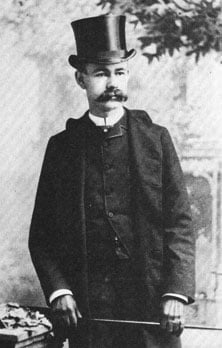
In 1879, William Petit Trowbridge appointed Hollerith as his assistant and chose Hollerith as a statistician during the U.S. census of 1880. This made Hollerith explore mechanical solutions to manipulate data.
In 1881, Hollerith taught mechanical engineering at the Massachusetts Institute of Technology for some time. Later at the U.S. Patent Office in Washington, D.C., he was appointed as an assistant patent examiner.
Hollerith returned to New York in 1887. He was wholly devoted to the design and improvement of his electric counting machines at the time, and they were a huge success, as he was awarded a contract by the Census Office when it reopened for the 1890 census. In 1890 at the Columbia School of Mines, Herman Hollerith was awarded a doctorate for his tabulating systems. His machines were then used in censuses in Canada, Norway, Russia, Austria, and other countries.
The main reason behind the invention of tabulating machines was that even though the 1880 census took only a few months to complete, the job of tabulating and evaluating the data was expected to take years. As a result, the census reports would be hopelessly out of date by the time it was completed; the government would be lucky if it finished in time for the next census in 1890. Furthermore, because the country’s population rose by the millions due to immigration, the 1890 census would likely entail much more time and money. The situation was out of hand, and the Census Bureau was scrambling for a solution. In this crisis, Hollerith stepped in when Dr. Billings drew his attention as he required some mechanical tool to compile the data of population and statistics. So the punch card tabulating machine, a groundbreaking technology, was first used in a federal government office in 1888.
Tabulating Machine: How It Worked
A tabulating machine would read one card at the moment, print bits of the card (fields) on fan-fold paper, rearrange them, and add one or more numbers punched on the card to one or more accumulators. To get totals on early models, the accumulator register dials were manually read after a card run. Later models could directly print totals. In addition, cards with a particular punch could be used as master cards, resulting in varied outcomes.
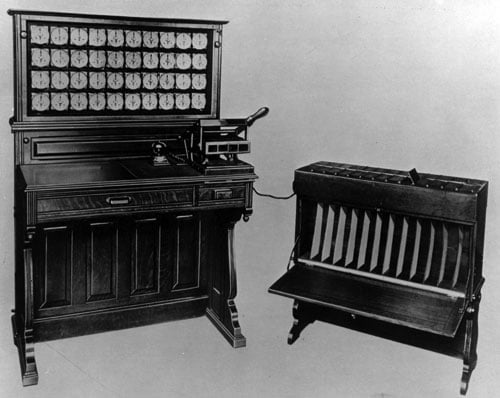
Customer master cards, for example, could be combined with sorted cards that track specific purchases. The billing address and customer number would be printed from the master card when the tabulating machine reads it to make invoices, followed by individual items purchased and prices. Finally, the total price would be printed from the accumulator and the page ejected to the top of the next page, typically using carriage control tape when the next master card was recognized.
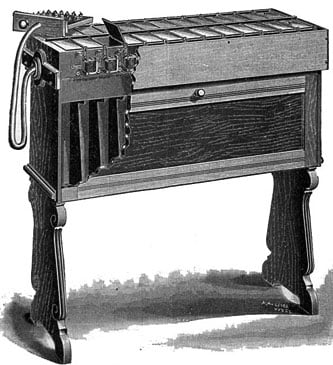
The sorter (see the nearby image) was simply a box with several compartments, positioned next to each tabulator. When a card with a desired set of characteristics passed through the reader, a box on the sorter opened up, and the operator slipped the card into it, then reset the dials, and positioned a new card to repeat the process. An experienced tabulator clerk could process 80 punch cards per minute.
Hollerith intended to power his tabulators with batteries and recharge them through the power outlet.
In 1884 he applied and in 1889 received his first patent for a tabulator (pat. No. US395783), for a tabulator with a paper tape. On the same date he received his first patent for a tabulator with punched cards (pat. No. US395781).
The Census Office was impressed with Hollerith’s work, but it decided to conduct an official test of the system before making a commitment. The trial in 1888 pitted Hollerith’s machines against the “chip” system of Charles Felton Pidgin (who invented the first electro-magnetic calculating machine in the world) and the “slip” system of William C. Hunt, both Census officials. In the chip system, data from the schedules were transcribed to colored cards; in the slip system, the information was written onto slips of paper in colored inks. In both cases, the cards and slips were counted by hand. The competition called for the transcription and tabulation of a thick sheaf of schedules, compiled during the 1880 census, covering 10491 people in St. Louis. There were two parts to the trial: the time required to transcribe the schedules and the time required to tabulate the data. Surprisingly, Hollerith’s system smashed the rivals. It showed its greatest advantage in the tabulation portion of the test, completing the job eight to ten times faster than the hand-counted slip and chip methods.
Hollerith’s punch card system received a great deal of attention in the popular and scientific press in the USA and abroad and was featured on the front tape of the 30 August 1890 issue of Scientific American (see it below).

If one had sufficient equipment, one could perform quite sophisticated calculations using consecutive stages or cycles of punched-card processing. (In current data processing terminology, each stage can be thought of as a SQL clause: SELECT (filter columns), WHERE (filter cards, or “rows”), possibly a GROUP BY for totals and counts, then a SORT BY; and finally, perhaps feed them back to another set of SELECT and WHERE cycles if needed.) A human operator had to retrieve, load, and store the various card decks at each stage.

The first tabulators made by Hollerith were used in the U.S. census 1890. Later many improved versions of tabulating machines were invented. For instance, In 1906, the Tabulating Machine Company (TMC) developed the first automatic feed tabulator, which could process 150 cards per minute. In 1920, the first TMC printing tabulator was created and later continued as TMC Type IV Accounting Machine, later renamed the IBM 301. These were further modified to form IBM 401, IBM 405, 402, and 407.
Tabulating Machines: Historical Significance
The tabulating machine was a groundbreaking invention of its time. Even though the U.S. 1880 census took only a few months to complete, tabulating and analyzing data took years. Since it took so long, the data compiled was out of date. It was predicted that the 1890 census would take a lot more time and money because the country’s population was growing by the millions due to immigration. At that time, the invention of tabulating machines helped analyze large amounts of data and compile them on time, which led to a successful census.
This invention was so successful for its time that it was later adopted in other countries as well. It was used to compile the censuses in Canada, Norway, Russia, Austria, and other countries.
Due to its significance, it represents the early stages of computer history even though the tabulating machine itself was not a computer. And its inventor, Herman Hollerith, is widely known as the father of modern machine data processing because the punched card tabulating the machine, which he invented, ushered in the age of automatic data processing. Previously, punched cards were used to control looms. Hollerith used them to hold data.
In effect, Hollerith cut his tape into sections (cards, which measures 3.25 by 7.375 inches, the same size as the 1887 US paper currency because Hollerith used Treasury Department containers as card boxes), and the result was a quick and versatile tabulating system. Once one had transcribed the information on the schedules to the cards, one could manually or electromechanically isolate any card or class of cards (so instead of serial access you have random access.) For instance, you could set aside a pile of cards representing nothing but farmers and perform any statistical analyses of this group you wished. You did not have to sift through the schedules all over again. Therefore, if you wanted to know how many farmers owned more than ten hundred acres and earned their income from wheat, you had only to run through the farmer cards, setting up the counters on the tabulator to match the appropriate holes in the cards.
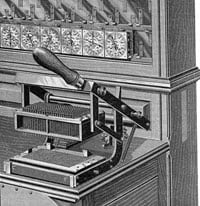
The decision to use cards led Hollerith to redesign his initial system. He designed a special puncher (a pantograph punch consisting of a template and two connected punches); when the operator punched the template, the second puncher perforated the card. The card reader (see the nearby image) was a small press made up of an overhead array of pins and an underlying bed of tiny cups of mercury; when the operator slipped a card into the press and pulled down on the handle, the pins passed through the holes into the mercury, closing electrical circuits that advanced the counters (each completed circuit caused an electromagnet to advance a counting dial by one number), 40 simple clock-like dials set into a wooden table. When the bell signaled the card had been read, the operator recorded the data on the dials, opened the card reader, removed the punch cards, and reset the dials.